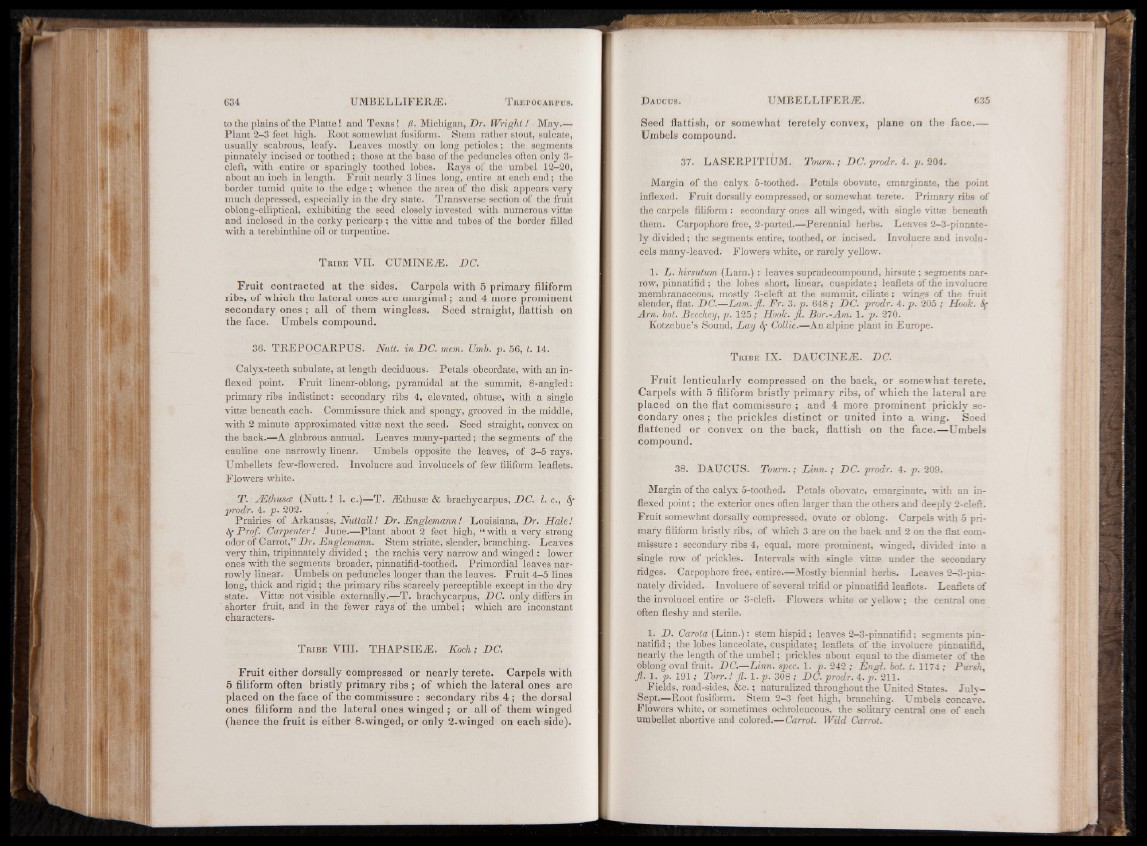
to the plains of the P la tte ! and T ex a s! 0. Michigan, Dr. Wright ! May.—
Plant 2-3 feet high. Root somewhat fusiform. Stem rather stout, sulcate,
usually scabrous, leafy. Leaves mostly on long petioles; the segments
pinnately incised or toothed ; those at the base of the peduncles often only 3-
cleft, with entire or sparingly toothed lobes. Rays of the umbel 12-20,
about an inch in length. Fruit nearly 3 lines long, entire at each end; the
border tumid quite to the edge ; whence the area of the disk appears very
much depressed, especially in the dry state. Transverse section of the fruit
oblong-elliptical, exhibiting the seed closely invested with numerous vittse
and inclosed in the corky pericarp ; the vittse and tubes of the border filled
with a terebinthine oil or turpentine.
T ribe VII. CUMINEiE. DC.
Fruit contracted at the sides. Carpels with 5 primary filiform
ribs, of which the lateral ones are marginal; and 4 more prominent
secondary ones ; all of them wingless. Seed straight, flattish on
the face. Umbels compound.
36. TREPOCARPUS. Nutt, in DC. mem. Umh. p. 56, t. 14.
Calyx-teeth subulate, at length deciduous. Petals obcordate, with an in-
flexed point. Fruit linear-oblong, pyramidal at the summit, 8-angled:
primary ribs indistinct: secondary ribs 4, elevated, obtuse, with a single
vitt* beneath each. Commissure thick and spongy, grooved in the middle,
with 2 minute approximated vittae next the seed. Seed straight, convex on
the back.—A glabrous annual. Leaves many-parted; the segments of the
cauline one narrowly linear. Umbels opposite the leaves, of 3-5 rays.
Umbellets few-flowered. Involucre aud involueels of few filiform leaflets.
Flowers-white.
T. JEthusce (N u tt.! 1. c.)—T . iEthusse & brachycarpus, DC. 1. c., Sf
prodr. 4. p. 202.
Prairies of Arkansas, Nuttall! Dr. Englemann! Louisiana, Dr. Hale!
6f Prof. Carpenter! June.—Plant about 2 feet high, “ with a very strong
odor of Carrot,” Dr. Englemann. Stem striate, slender, branching. Leaves
very thin, tripinnately divided; the rachis very narrow and winged : lower
ones with the segments broader, pinnatifid-toothed. Primordial leaves narrowly
linear. Umbels on peduncles longer than the leaves. Fruit 4-5 lines
long, thick and rigid; the primary ribs scarcely perceptible except in the dry
state. Vittae not visible externally.—T. brachycarpus, DC. only differs in
shorter fruit, and in the fewer rays of the umbel; which are inconstant
characters.
T ribe V III. T H A P S IE iE . Koch; DC.
Fruit either dorsally compressed or nearly terete. Carpels with
5 filiform often bristly primary ribs ; of which the lateral ones are
placed on the face of the commissure : secondary ribs 4 ; the dorsal
ones filiform and the lateral ones winged ; or all of them winged
(hence the fruit is either 8-winged, or only 2-winged on each side).
Seed flattish, or somewhat teretely convex, plane on the face.—
Umbels compound.
37. LASERPITIUM. Tourn.; DC. prodr. 4. p. 204.
Margin of the calyx 5-toothed. Petals obovate, emarginate, the point
inflexed. Fruit dorsally compressed, or somewhat terete. Primary ribs of
the carpels filiform : secondary ones all winged, with single vitt® beneath
them. Carpophore free, 2-parted.—Perennial herbs. Leaves 2-3-pinnate-
]y divided; the segments entire, toothed, or incised. Involucre and involu-
cels many-leaved. Flowers white, or rarely yellow.
1. L. hirsutum (Lam.): leaves supradecompound, hirsute ; segments narrow,
pinnatifid ; the lobes short, linear, cuspidate; leaflets of the involucre
membranaceous, mostly 3-cleft at the summit, eiliate; wings of the fruit
slender, flat. DC.—Lam. fl. Fr. 3. p. 648; DC. prodr. 4. p. 205 ; Hook.
Am. hot. Beechey, p. 125 ; Hook. fl. Bor.-Am. 1. p. 270.
Kotzebue’s Sound, Lay &f Collie.—An alpine plant in Europe.
T r ib e IX. DAUCINEiE. DC.
Fruit lenticularly compressed on the back, or somewhat terete.
Carpels with 5 filiform bristly primary ribs, of which the late ra l are
placed on the flat commissure ; and 4 more prominent prickly secondary
ones ; the prickles distinct or united into a wing. Seed
flattened or convex on the back, flattish on the face.—Umbels
compound.
38. DAUCUS. Tourn.; L in n .; DC. prodr. 4. p. 209.
Margin of the calyx 5-toothed. Petals obovate, emarginate, with an in-
flexed point; the exterior ones often larger than the others and deeply 2-cleft.
Fruit somewhat dorsally compressed, ovate or oblong. Carpels with 5 primary
filiform bristly ribs, of which 3 are on the back and 2 on the flat commissure
: secondary ribs 4, equal, more prominent, winged, divided into a
single row of prickles. Intervals with single vittae under the secondary
ridges. Carpophore free, entire.—Mostly biennial herbs. Leaves 2-3-pin-
nately divided^ Involucre of several trifid or pinnatifid leaflets. Leaflets of
the involucel entire or 3-cleft. Flowers white or yellow; the central one
often fleshy and sterile.
1. D. Carota (Linn.): stem hispid ; leaves 2—3-pinnatifid; segments pinnatifid
; the lobes lanceolate, cuspidate; leaflets of the involucre pinnatifid,
nearly the length of the umbel; prickles about equal to the diameter of the
oblong oval fruit. DC.—Linn. spec. 1. p. 242 ; Engl. hot. t. 1174 ; Pursh,
fl. 1. p. 191; Torr.! fl. 1. p. 308 ; DC. prodr. 4. p . 211.
Fields, road-sides, &c.; naturalized throughout the United States. Jnly-
Sept.—Root fusiform. Stem 2-3 feet high, branching. Umbels concave.
Flowers white, or sometimes ochroleucous, the solitary central one of each
umbellet abortive and colored.— Carrot. Wild Carrot.